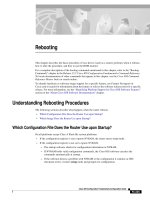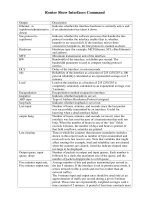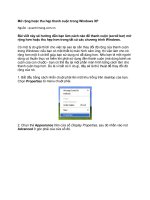Tài liệu mở rộng quản trị mạng Router Boot Process
Bạn đang xem bản rút gọn của tài liệu. Xem và tải ngay bản đầy đủ của tài liệu tại đây (119.73 KB, 16 trang )
FC-225
Cisco IOS Configuration Fundamentals Configuration Guide
Rebooting
This chapter describes the basic procedure a Cisco device (such as a router) performs when it reboots,
how to alter the procedure, and how to use the ROM monitor.
For a complete description of the booting commands mentioned in this chapter, refer to the “Booting
Commands” chapter in the Release 12.2 Cisco IOS Configuration Fundamentals Command Reference.
To locate documentation of other commands that appear in this chapter, use the Cisco IOS Command
Reference Master Index or search online.
To identify hardware or software image support for a specific feature, use Feature Navigator on
Cisco.com to search for information about the feature or refer to the software release notes for a specific
release. For more information, see the “Identifying Platform Support for Cisco IOS Software Features”
section in the “About Cisco IOS Software Documentation” chapter.
Understanding Rebooting Procedures
The following sections describe what happens when the router reboots:
•
Which Configuration File Does the Router Use upon Startup?
•
Which Image Does the Router Use upon Startup?
Which Configuration File Does the Router Use upon Startup?
On all platforms except Class A Flash file system platforms:
•
If the configuration register is set to ignore NVRAM, the router enters setup mode.
•
If the configuration register is not set to ignore NVRAM,
–
The startup software checks for configuration information in NVRAM.
–
If NVRAM holds valid configuration commands, the Cisco IOS software executes the
commands automatically at startup.
–
If the software detects a problem with NVRAM or the configuration it contains (a CRC
checksum error), it enters setup mode and prompts for configuration.
Rebooting
Understanding Rebooting Procedures
FC-226
Cisco IOS Configuration Fundamentals Configuration Guide
On Class A Flash file system platforms:
•
If the configuration register is set to ignore NVRAM, the router enters setup mode.
•
If the configuration register is not set to ignore NVRAM,
–
The startup software uses the configuration pointed to by the CONFIG_FILE environment
variable.
–
When the CONFIG_FILE environment variable does not exist or is null (such as at first-time
startup), the router uses NVRAM as the default startup device.
–
When the router uses NVRAM to start up and the system detects a problem with NVRAM or
the configuration it contains, the router enters setup mode.
Problems can include a bad checksum for the information in NVRAM or an empty NVRAM with no
configuration information. Refer to the “Troubleshooting Hardware and Booting Problems” chapter
publication Internetwork Troubleshooting Guide for troubleshooting procedures. See the “Using Setup
for Configuration Changes” chapter in this publication for details on the setup command facility. For
more information on environment variables, refer to the “Setting Environment Variables” section.
Which Image Does the Router Use upon Startup?
When a router is powered on or rebooted, the following events happen:
•
The ROM monitor initializes.
•
The ROM monitor checks the boot field (the lowest four bits) in the configuration register.
–
If the last digit of the boot field is 0 (for example, 0x100), the system does not boot. Instead the
system enters ROM monitor mode and waits for user intervention. From ROM monitor mode,
you can manually boot the system using the boot or b command.
–
If the last digit of the boot field is1 (for example, 0x101), the boot helper image is loaded from
ROM. (On some platforms, the boot helper image is specified by the BOOTLDR environment
variable.)
–
If the last digit of the boot field is 2 through F (for example, 0x102 through 0x10F), the router
boots the first valid image specified in the configuration file or specified by the BOOT
environment variable.
Note
The configuration register boot field value is expressed in hexadecimal. Because the boot field only
encompasses the last four bits (represented by the last hexadecimal digit) of the configuration register
value, the only digit we are concerned with in this discussion is the last digit. The makes 0x1 (0000
0001) equivalent to 0x101 (1 0000 0001) in discussions of the boot field, as in both cases the last four
bits are 0001.
When the boot field is 0x102 through 0x10F, the router goes through each boot system command in
order until it boots a valid image. If bit 13 in the configuration register is set, each command will be tried
once (bit 13 is indicated by the position occupied by b in the following hexadecimal notation: 0xb000).
If bit 13 is not set, the boot system commands specifying a network server will be tried up to five more
times. The timeouts between each consecutive attempt are 2, 4, 16, 256, and 300 seconds.
Rebooting
Understanding Rebooting Procedures
FC-227
Cisco IOS Configuration Fundamentals Configuration Guide
If the router cannot find a valid image, the following events happen:
•
If all boot commands in the system configuration file specify booting from a network server and all
commands fail, the system attempts to boot the first valid file in Flash memory.
•
If the “boot-default-ROM-software” option in the configuration register is set, the router will start
the boot image (the image contained in boot ROM or specified by the BOORLDR environment
variable).
•
If the “boot-default-ROM-software” option in the configuration register is not set, the system waits
for user intervention at the ROM monitor prompt. You must boot the router manually.
•
If a fully functional system image is not found, the router will not function and must be reconfigured
through a direct console port connection.
Note
Refer to your platform documentation for information on the default location of the boot image.
When looking for a bootable file in Flash memory:
•
The system searches for the filename in Flash memory. If a filename is not specified, the software
searches through the entire Flash directory for a bootable file instead of picking only the first file.
•
The system attempts to recognize the file in Flash memory. If the file is recognized, the software
decides whether it is bootable by performing the following checks:
–
For run-from-Flash images, the software determines whether it is loaded at the correct execution
address.
–
For run-from-RAM images, the software determines whether the system has enough RAM to
execute the image.
Figure 12 illustrates the basic booting decision process.
Rebooting
Understanding Rebooting Procedures
FC-228
Cisco IOS Configuration Fundamentals Configuration Guide
Figure 12 Booting Process
The
ROM monitor
initializes
What is
the configuration
register boot
field?
0
Yes
Yes
Yes
No
No
No
Yes
1
No Yes
2 through F
No
No
Yes
No
Are there
boot system
commands in the
configuration
file?
The system does not
boot an image but
waits for commands
at the ROM monitor
prompt
The router tries the
first boot system
command
The router boots the
boot image in boot
ROM or boot flash
The router loads
the image in the
Flash device
The router tries to
boot from the network
using the default
image name
The router is
ready to use
Yes
The router is
ready to use
The router tries the
next boot system
command
The router boots
the image in
Flash memory
The router boots the
boot image in boot
ROM or boot flash
The router boots the
boot image in boot
ROM or boot flash
Was a
valid image
loaded?
Are there
more boot
system
commands?
Was
the netboot
successful?
Did all
of the boot
system commands
specify
netbooting?
Is there
a valid image
in Flash
memory?
Is there
a valid image
in the default
Flash device?
S6750
Rebooting
Rebooting Task List
FC-229
Cisco IOS Configuration Fundamentals Configuration Guide
Rebooting Task List
Tasks related to rebooting are described in the following sections:
•
Displaying Boot Information
•
Modifying the Configuration Register Boot Field
•
Setting Environment Variables
•
Scheduling a Reload of the System Image
•
Entering ROM Monitor Mode
•
Manually Loading a System Image from ROM Monitor
Displaying Boot Information
Use the following commands in EXEC mode to display information about system software, system
image files, and configuration files:
Refer to the Release 12.2 Cisco IOS Configuration Fundamentals Command Reference for examples of
these commands.
You can also use the o command (or the confreg command for some platforms) in ROM monitor mode
to list the configuration register settings on some platforms.
Modifying the Configuration Register Boot Field
The configuration register boot field determines whether the router loads an operating system image, and
if so, where it obtains this system image. This section contains the following topics:
•
How the Router Uses the Boot Field
•
Hardware Versus Software Configuration Register Boot Fields
•
Modifying the Software Configuration Register Boot Field
Refer to the documentation for your platform for more information on the configuration register.
Command Purpose
Router# show bootvar
Lists the contents of the BOOT environment variable, the
name of the configuration file pointed to by the
CONFIG_FILE environment variable, and the contents of
the BOOTLDR environment variable.
Router# more nvram:startup-config
Lists the startup configuration information.
On all platforms except the Class A Flash file systems, the
startup configuration is usually in NVRAM. On Class A
Flash file systems, the CONFIG_FILE environment variable
points to the startup configuration, defaulting to NVRAM.
Router# show version
Lists the system software release version, system image
name, configuration register setting, and other information.
Rebooting
Modifying the Configuration Register Boot Field
FC-230
Cisco IOS Configuration Fundamentals Configuration Guide
How the Router Uses the Boot Field
The lowest four bits of the 16-bit configuration register (bits 3, 2, 1, and 0) form the boot field. The
following boot field values determine if the router loads an operating system and where it obtains the
system image:
•
When the entire boot field equals 0-0-0-0 (0x0), the router does not load a system image. Instead, it
enters ROM monitor or “maintenance” mode from which you can enter ROM monitor commands to
manually load a system image. Refer to the “Manually Loading a System Image from ROM
Monitor” section for details on ROM monitor mode.
•
When the entire boot field equals 0-0-0-1 (0x1), the router loads the boot helper or rxboot image.
•
When the entire boot field equals a value between 0-0-1-0 (0x2) and 1-1-1-1 (0xF), the router loads
the system image specified by boot system commands in the startup configuration file. When the
startup configuration file does not contain boot system commands, the router tries to load a default
system image stored on a network server.
When loading a default system image from a network server, the router uses the configuration
register settings to determine the default system image filename for booting from a network server.
The router forms the default boot filename by starting with the word cisco and then appending the
octal equivalent of the boot field number in the configuration register, followed by a hyphen (-) and
the processor type name (cisconn-cpu). See the appropriate hardware installation guide for details
on the configuration register and the default filename.
Hardware Versus Software Configuration Register Boot Fields
You modify the boot field from either the hardware configuration register or the software configuration
register, depending on the platform.
Most platforms have use a software configuration register. Refer to your hardware documentation for
information on the configuration register for your platform.
The hardware configuration register can be changed only on the processor card with dual in-line package
(DIP) switches located at the back of the router. For information on modifying the hardware
configuration register, refer to the appropriate hardware installation guide.
Modifying the Software Configuration Register Boot Field
To modify the software configuration register boot field, use the following commands:
Command Purpose
Step 1
Router# show version
Obtains the current configuration register setting. The
configuration register is listed as a hexadecimal value.
Step 2
Router# configure terminal
Enters global configuration mode.
Step 3
Router(config)# config-register
value
Modifies the existing configuration register setting to reflect
the way in which you want to load a system image. The
configuration register value is in hexadecimal form with a
leading “0x.”
Step 4
Router(config)# end
Exits configuration mode.









